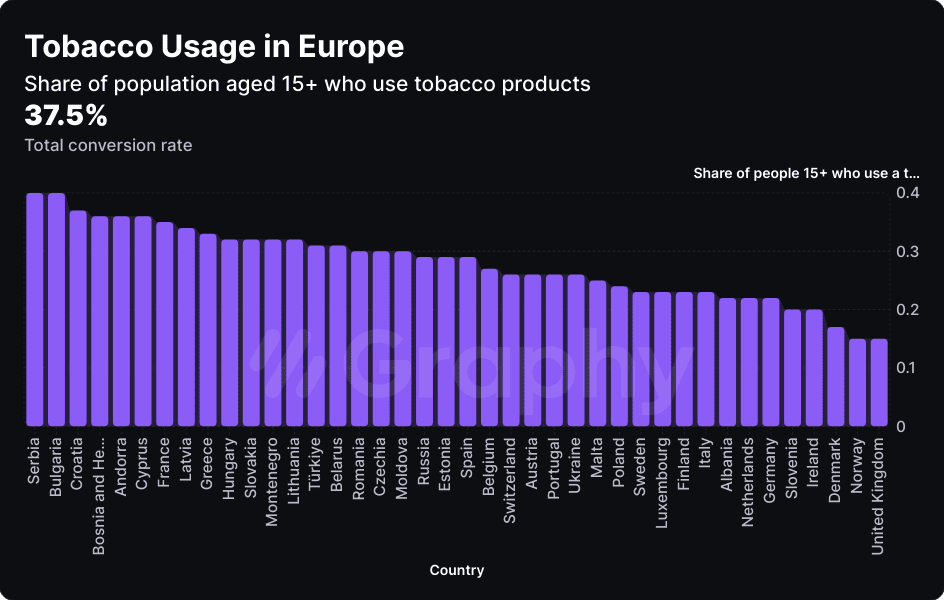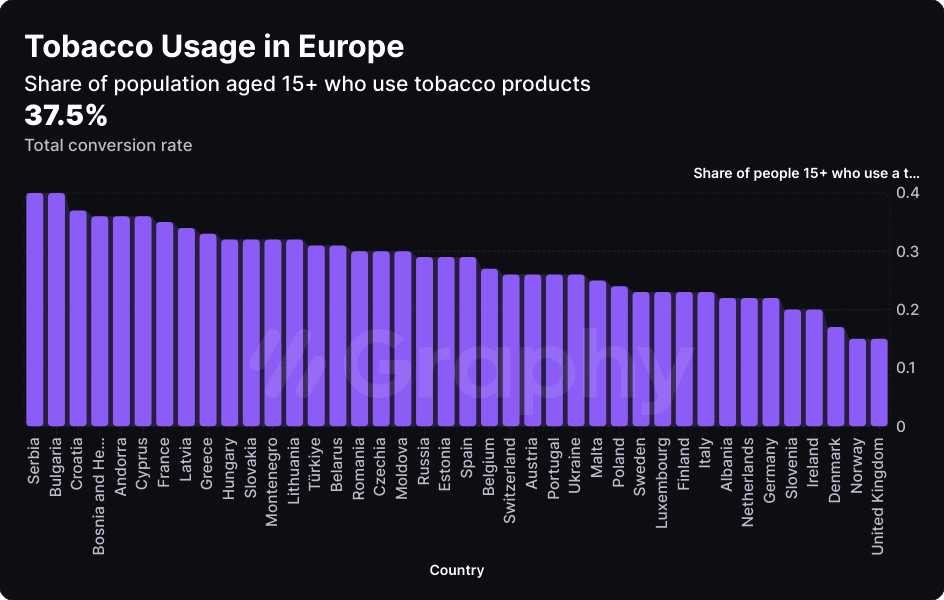Tobacco use remains a significant public health challenge in Europe, with smoking being the leading cause of premature death among European Union countries. To gain a better understanding of this complex issue, let's take a closer look at the rates of tobacco use across various European nations and explore some of the factors that may contribute to these patterns.
Visualizing Tobacco Use Rates in Europe
The table below offers a helpful starting point for our exploration. It visualizes the percentage of each European country's population aged 15 and older who use tobacco products, using data from the World Health Organization for the year 2021.
Think of this map as a visual representation of the tobacco use landscape in Europe. Just as a topographical map shows the highs and lows of a physical landscape, this map reveals the "peaks" and "valleys" of tobacco consumption across the continent. By studying these patterns, we can begin to identify areas where tobacco use is particularly prevalent and consider the factors that may be driving these trends.

European Countries by Tobacco Usage Rate
| Rank | Country | Usage Rate |
|---|---|---|
| 1 |
|
40% |
| 1 |
|
40% |
| 3 |
|
37% |
| 4 |
|
36% |
| 4 |
|
36% |
| 4 |
|
36% |
| 7 |
|
35% |
| 8 |
|
34% |
| 9 |
|
33% |
| 10 |
|
32% |
| 10 |
|
32% |
| 10 |
|
32% |
| 10 |
|
32% |
| 14 |
|
31% |
| 14 |
|
31% |
| 16 |
|
30% |
| 16 |
|
30% |
| 16 |
|
30% |
| 19 |
|
29% |
| 19 |
|
29% |
| 19 |
|
29% |
| 22 |
|
27% |
| 23 |
|
26% |
| 23 |
|
26% |
| 23 |
|
26% |
| 23 |
|
26% |
| 27 |
|
25% |
| 28 |
|
24% |
| 29 |
|
23% |
| 29 |
|
23% |
| 29 |
|
23% |
| 29 |
|
23% |
| 33 |
|
22% |
| 33 |
|
22% |
| 33 |
|
22% |
| 36 |
|
20% |
| 36 |
|
20% |
| 38 |
|
17% |
| 39 |
|
15% |
Identifying High-Use Countries
When we examine the data more closely, we see that some countries stand out for their high rates of tobacco use. Bulgaria and Serbia, for example, have the highest usage rates in Europe, with 40% of their populations using tobacco products. Neighboring countries like Croatia (37%) and Bosnia and Herzegovina (36%) also have notably high rates.
To put these numbers in perspective, let's consider what they mean in practical terms. In a country with a 40% tobacco use rate, four out of every ten people aged 15 and older are using tobacco products. This is a significant portion of the population, and it underscores the scale of the public health challenge that tobacco use presents in these countries.
Understanding Regional Patterns
As we look at the dataset, we might notice that many of the countries with the highest tobacco use rates are located in Eastern Europe. This is not a coincidence; there are several factors that may contribute to this regional pattern.
One key factor is the historical smoking culture in many Eastern European countries. For decades, smoking has been deeply ingrained in social and cultural norms in this region, which can make it more difficult to change attitudes and behaviors around tobacco use.
Another factor is the strength of tobacco control policies in different countries. Eastern European countries have often had weaker regulations around tobacco marketing, sales, and use compared to other parts of Europe. This can create an environment where tobacco products are more easily accessible and where there are fewer incentives to quit smoking.
Economic hardship is another important consideration. Studies have shown that lower socio-economic status is a key factor influencing smoking habits in both men and women. In countries where economic challenges are more prevalent, people may be more likely to turn to tobacco as a coping mechanism or as a relatively affordable "luxury" item.
Identifying Low-Use Countries
On the other end of the spectrum, we see that some countries have notably low rates of tobacco use. The United Kingdom and Norway, for example, have the lowest usage rates in Europe, with only 15% of their populations using tobacco products.
To understand how these countries have achieved such low rates, it can be helpful to consider the strategies they have used to combat tobacco use. Both the UK and Norway have implemented comprehensive tobacco control policies over the years, including measures like high taxes on tobacco products, strict regulations on tobacco advertising and promotion, and well-funded smoking cessation programs.
These policies create an environment where tobacco products are less accessible, less affordable, and less socially acceptable. Over time, this can lead to significant reductions in tobacco use rates, as we see in these countries.
The European Context
Finally, it's important to consider these country-specific patterns within the broader European context. Across Europe as a whole, an average of 26% of people use tobacco products. This means that even in countries with relatively low use rates, tobacco use remains a significant public health issue.
To address this challenge, European countries have increasingly collaborated on tobacco control efforts through initiatives like the European Union's Tobacco Products Directive. This directive sets common standards for tobacco products across EU countries, including regulations on packaging, labeling, and ingredients.
By working together and learning from each other's successes and challenges, European countries can continue to make progress in reducing tobacco use and improving public health outcomes.
Conclusion
Tobacco use in Europe is a complex issue that varies significantly from country to country. By examining patterns of tobacco use across the continent, we can gain insights into the factors that contribute to high rates of use in some areas and the strategies that have been effective in reducing use in others.
Ultimately, tackling tobacco use in Europe will require a sustained, multi-faceted approach that addresses the social, economic, and cultural factors that influence smoking habits. This might include measures like strengthening tobacco control policies, investing in smoking cessation programs, and working to change social norms around smoking.
As individuals, we can also play a role in this effort by educating ourselves about the risks of tobacco use, supporting friends and loved ones who are trying to quit, and advocating for policies that prioritize public health.
By working together and taking a comprehensive, evidence-based approach, we can continue to reduce tobacco use in Europe and create a healthier future for all.








